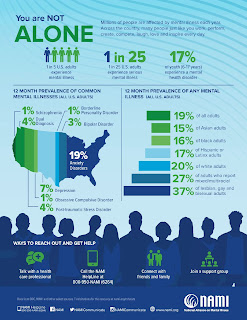 |
| Mental Health Infographic (National Alliance on Mental Illness) |
Reflection: From my research, I was most surprised when learning more about the difference in treatment of physical and mental illness in professional settings. One case was especially horrifying, in which a patient’s symptoms associated with mental illness were brought to a doctors attention, and dismissed by the doctor, later resulting in the patient's death. I was devastated to hear that even a doctor, one of the most educated professionals, had succumbed to society’s stigma. Later in my research, I discovered that the distinction between physical and mental illness is more common than I thought. Even in schools, teachers are trained significantly less on how to handle mental illness when approached by a student, compared to a physical illness, like an allergic reaction. At the beginning of my research, I believed that the stigma surrounding mental illness was on the rise, but I now know it’s the contrary. The number of people acknowledging their mental illness is increasing, and this is largely due to the decrease in stigma and growth of acceptance and understanding. For example, therapy is now a common practice, whether you have mental health issues or not. People are less afraid to discuss their mental illness with friends, family, and even casual acquaintances. If I had the opportunity, I would continue my research into mental health stigma within minority groups. I noticed many articles focused on why the stigma is greater within minority groups, finding that it’s commonly seen as a sign of weakness, and therefore shamed. I found the topic of language surrounding stigma to be most interesting, because words like “psycho” or “crazy” are used in such a casual sense, that I rarely think twice when hearing or saying them myself. Yet, after researching, I understand why these words can be offensive to those with a diagnosed mental illness or disorder, as they are used out of context and in a derogatory way. I thoroughly enjoyed learning about this topic, and hope to apply it to my own life as I attempt to create a less stigmatized environment for those around me.
No comments:
Post a Comment